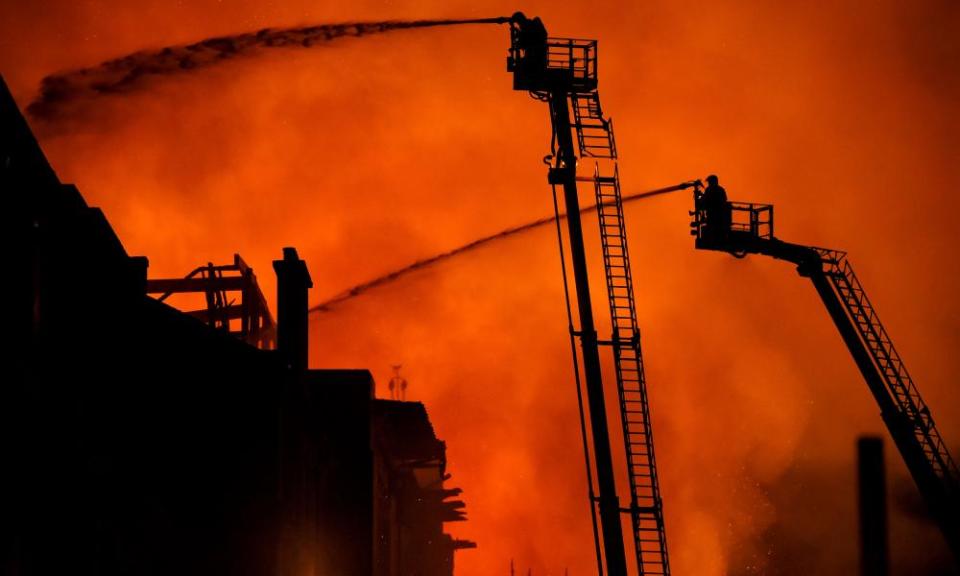Glasgow School of Art: sprinklers had not been fitted after first fire
Hopes have been raised that Glasgow School of Art’s Mackintosh building, which was gutted by fire on Friday, can be saved as it emerged a new sprinkler system had not yet been fitted as part of the restoration following an earlier blaze.
On Sunday, as fire crews used thermal imaging cameras to identify any remaining hotspots, conservation experts argued that a fresh recovery project could build on the detail, skill and knowledge accumulated during the restoration of the treasured Mackintosh Library, which was almost entirely destroyed by fire in May 2014.
Disbelief and sympathy has been expressed across the world over the misfortune of the building, considered the masterwork of the art nouveau architect and designer Charles Rennie Mackintosh, after it was engulfed in flames for a second time.
A spokesperson for the British Automatic Fire Sprinkler Association said it was understood that automatic fire sprinklers had not been fully fitted as the building was still undergoing refurbishment from the 2014 fire.
In a statement, the BAFSA added: “However, it should be realised that sprinklers can be fitted in buildings throughout construction on a temporary basis, as there is a considerable risk from fire during this period.”
More than 120 firefighters and 20 fire engines were called to tackle the blaze, which was reported at about 11.20pm on Friday by a passing police officer. The flames spread to neighbouring music venues, the O2 ABC and the Campus nightclub on Sauchiehall Street.
The fire service said on Saturday that forensic crews had not yet been able to access the building because of safety concerns but that an investigation into the cause had begun.
The 2014 fire began when flammable gases from a foam canister used in a student project were ignited accidentally. A report by the Scottish fire and rescue service concluded that old ventilation ducts helped it spread into neighbouring studios and upwards through the building.
Some of those who viewed the site on Saturday raised concerns about whether the building’s stonework would survive a second round of intense heat.

But Miles Glendinning, professor of architectural conservation at the University of Edinburgh, told the Guardian: “When a building has multiple fires it doesn’t mean that it can’t be saved, so long as the shell is still there it is still possible to do.”
Glendinning pointed to the extensive postwar reconstruction undertaken in Germany, where many key public buildings were damaged by fire – some more than once. “In Germany, the problem would have been lack of knowledge, but the GSA took the very foresighted decision to do a detailed digital modelling of the entire building after the last fire, not just the wing that had been damaged, so this won’t be a problem.”
Glendinning said a combination of photographs and very detailed measurements were used to create a 3D image of the whole building, which could now be converted into contract drawings for restoration architects.
As bands cancelled scheduled appearances at the O2 ABC music venue, which lost much of its domed roof after the fire spread from the art school on Friday night, the leader of Glasgow City council Susan Aitken pledged to convene a Sauchiehall Street taskforce early this week to plan the area’s future.
Paul Sweeney, the Scottish Labour MP for Glasgow North East who sits on the board of the Glasgow Building Preservation Trust, echoed the concerns of the BAFSA. “I was rather surprised at the lack of active fire prevention patrols at the building. In hindsight, there should have been much more done.”
However, Sweeney, who toured the site on Saturday night, said he remained hopeful that the shell of the building could be saved. “The side of the building where the library was, the 1909 extension, has been entirely gutted. It’s back to bricks and ashes, but the structural beams and walls look fairly solid.”
He said the worst damage had been sustained by the east side of the building, which had been far less affected by the previous fire. “It looks like the fire started there, and it looks much worse inside, with the stone work splintered by heat around the big windows that look out onto Renfrew Street. On the eastern side wall you can see visible splits in the stone where the gable has shifted, but even that can be built up again in time.”
“I think you can write off any hope that anything is left internally, but the stone and steel is still holding up, so there is a good chance that you could have a facade retention structure in place and then begin restoration again. We already have a critical mass of knowledge and craftsmanship built up from the last fire.”
Sweeney said he believed many of the restored fixtures and fittings for the Mackintosh Library remained in storage, and were undamaged by the second fire.

 Yahoo News
Yahoo News 
